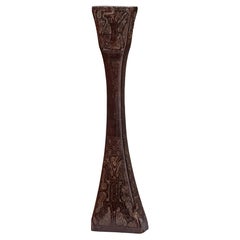Macana Club
Antique Early 18th Century Brazilian Native American Objects
Hardwood
On the Origins of Brazilian
More often than not, vintage mid-century Brazilian furniture designs, with their gleaming wood, soft leathers and inviting shapes, share a sensuous, unique quality that distinguishes them from the more rectilinear output of American and Scandinavian makers of the same era.
Commencing in the 1940s and '50s, a group of architects and designers transformed the local cultural landscape in Brazil, merging the modernist vernacular popular in Europe and the United States with the South American country's traditional techniques and indigenous materials.
Key mid-century influencers on Brazilian furniture design include natives Oscar Niemeyer, Sergio Rodrigues and José Zanine Caldas as well as such European immigrants as Joaquim Tenreiro, Jean Gillon and Jorge Zalszupin. These creators frequently collaborated; for instance, Niemeyer, an internationally acclaimed architect, commissioned many of them to furnish his residential and institutional buildings.
The popularity of Brazilian modern furniture has made household names of these designers and other greats. Their particular brand of modernism is characterized by an émigré point of view (some were Lithuanian, German, Polish, Ukrainian, Portuguese, and Italian), a preference for highly figured indigenous Brazilian woods, a reverence for nature as an inspiration and an atelier or small-production mentality.
Hallmarks of Brazilian mid-century design include smooth, sculptural forms and the use of native woods like rosewood, jacaranda and pequi. The work of designers today exhibits many of the same qualities, though with a marked interest in exploring new materials (witness the Campana Brothers' stuffed-animal chairs) and an emphasis on looking inward rather than to other countries for inspiration.
Find a collection of vintage Brazilian furniture on 1stDibs that includes chairs, sofas, tables and more.
Finding the Right Native-american-objects for You
As part of thoughtful home decor, antique and vintage Native American objects — works created by Native American artists and artisans — can bring rich textures and colors into a space.
Art collecting can be done in a socially and environmentally conscious way that reinvests in local communities. Tribal art is traditionally crafted with earth-friendly materials that respect the environment.
Textiles have long been objects of art and utility for Native Americans. Traditional weaving techniques involve material made from plant and animal fibers. Different tribes have woven distinctive patterns and colors into blankets, rugs and garments, such as the vibrant geometric shapes woven from wool by the Navajo.
After metal and glass beads were introduced to North America by Europeans, they became a popular form of art. Intricate beading appears on clothing, jewelry and other objects. Beadwork not only looks stunning, but it is also deeply emblematic of Native American ethnicity and can be used to pass stories handed down from generation to generation. Beaded garments have often been commissioned for important events like weddings, dances and celebrations.
Native Americans initially created pottery out of necessity to carry water and store food. For centuries, artists have decorated jugs, vases and other vessels, from designs etched into clay to experimentation with firing methods for unique finishes.
Find a diverse collection of colorful and culturally enriching antique and vintage Native American decorative items, objects and much more on 1stDibs.
Read More
A Giant Wedding Cake Has Us Looking at Portuguese Tiles in a New Light
At Waddesdon Manor, artist Joana Vasconcelos has installed a three-tiered patisserie inspired by the narrative tile work of her homeland. We take a look at the cake sculpture and how Portuguese tiles have been used in architecture from the 17th century to today.
Why Jules Chéret Was the King of the Modern Poster
The streets of fin-de-siècle Paris were set aglow with colorful poster ads, thanks to the printing techniques invented by Jules Chéret. Now, the Milwaukee Art Museum is celebrating this undersung talent in America's first solo show dedicated his exuberant works.
Why the American Flag Has Had So Many Different Star Patterns
Expert Jeff Bridgman explains the history and meaning behind the twinkling constellations that have graced Old Glory.
Peggy Guggenheim Loved Modernism, but She Also Collected Tribal Art
The iconoclastic style setter displayed African and Oceanic art, as well as works by indigenous peoples of the Americas, alongside pieces by such major modernists as Pablo Picasso and Jackson Pollock.
The 13-Star American Flag Had More Variations Than You’d Think
Perfect for July 4th weekend, a new show at Philadelphia's Museum of the American Revolution displays an array of antique red, white and blue flags.
Tramp Art, America’s Most Misunderstood Art Form, Is Trending in Interiors
Designers are beginning to see this enigmatic form of folk art in a whole new light.
